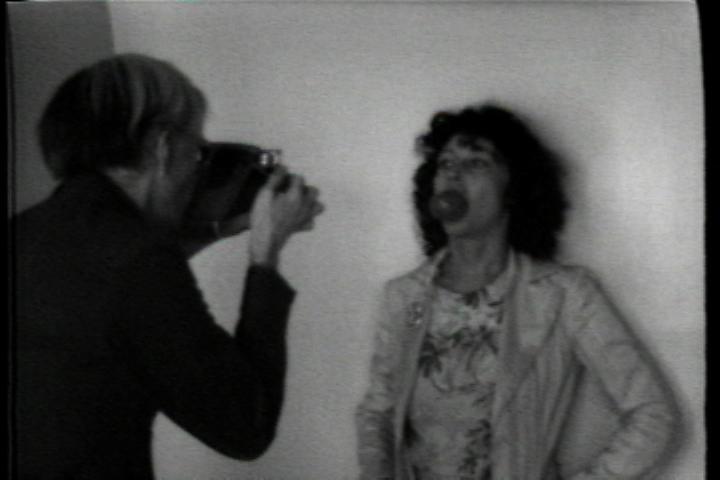(Isabelle Collin Dufresne, September 6, 1935-June 14, 2014)
A cultural figure who perhaps could only have existed in the 1960s, the actress and artist Ultra Violet achieved fame as a Warhol Superstar, yet she appeared in very few of his films. As Warhol’s biographers David Bourdon and Fred Lawrence Guiles have both noted, her penchant for publicity helped place her among those who are most-closely associated with Warhol; she had a sixth sense for photo ops. She was also the first Superstar to publish her Warhol memoirs after his passing in 1987, with a title borrowing the quotation which is so closely linked to him: “Famous for Fifteen Minutes.”
According to her book, they met in December 1963 when the great Spanish Surrealist painter, Salvador Dali (1904-1989), with whom Dufresne (as she was then known) had been associated for the previous five years as model and muse brought her to Warhol’s newest studio, The Factory, on East 47th Street. Although Warhol correctly wrote that it was 1965, he did immediately invite her to appear in his films. She describes her “exquisite Chanel suit woven of gold-pink-blue thread” that Warhol later described in both POPism and his posthumous Diaries, recounting the Palm Sunday luncheon given by Dali in 1978 at which Ultra wore the very same suit she had worn at their first meeting.
Warhol also noted that Ultra bought a Flowers painting that day in 1965, one of the largest from that series, for $500. In his memoir of the 1960s, POPism, Warhol wrote that the painting was still wet, and that she was not yet “Ultra Violet” nor had yet started dying her hair purple. He also noted that she reminded him of the Hollywood star Vivien Leigh, and it was her physical beauty that no doubt made him contact Ultra when the photographers came around.
The Flowers painting was in her collection for several decades; she loaned it to the Warhol Museum for a short time soon after the museum opened. Ultra was one of the Superstars who attended the museum’s grand opening in 1994, and also took part in its inaugural symposium in 1995, “Warhol’s Worlds.”
Among the Warhol films Ultra Violet appeared in were three Screen Tests, The Life of Juanita Castro in 1965, I a Man, and several reels of Four Stars in 1967. She was also one of the Warhol Superstars who were cast as members of the underground in John Schlesinger’s Midnight Cowboy in 1968. She appeared in many other films over the following years, but her sole ensuing project with Warhol that bore tangible results was her eponymous music recording in 1973, for which Warhol provided a single Polaroid photo of bug-eyed Ultra with a big red apple held in her mouth. The photo is printed on the back cover of the LP, rather than the front, which featured a photograph of what Warhol described as her “incredibly long tongue.”

Factory Diary: Ultra Violet Album Cover Design Session, August 23, 1973, 1973
½” reel-to-reel videotape, black-and-white, sound, 33 minutes.
The Andy Warhol Museum, Pittsburgh; Contribution of The Andy Warhol Foundation for the Visual Arts, Inc.
© The Andy Warhol Museum, Pittsburgh, PA, a museum of Carnegie Institute. All rights reserved.
She also took roles on the stage, perhaps most significantly in John Vaccaro’s production of Charles Ludlam’s Conquest of the Universe, at which Marcel Duchamp requested to meet the cast in 1968. In the fall of that year, she was featured in a trio including her fellow superstar Viva and Warhol on the cover of The New York Times Magazine, in a story about Warhol’s return to activity following the assassination attempt on June 3 that year. She was also among five of “Andy’s Girls,” a feature in issue 3 of the short-lived magazine Avant-Garde in 1968. A color poster of her, fully nude in bed, under Roy Lichtenstein’s enormous red Pop banner of a handgun, was widely available at that time.
Previously to her years with Dali, Isabelle associated with the elderly English surrealist painter John Graham (1886-1961). She was later involved with the American sculptor John Chamberlain (1927-2011), of Warhol’s generation. All of her affairs with artists seem to have been prompted by her rebellion against her conservative family. Her father was a wealthy French businessman; she was educated (her website notes she earned a BA in Art from Le Sacre Coeur in Grenoble, in 1953), and left for America at the age of 17. She is said to have undergone exorcism by a Catholic priest in 1948; a “near-death experience” in 1973 resulted in her return to Christianity, to the Church of Jesus Christ of Latter-Day Saints. It’s difficult to say precisely whether or how this may be related to a performance she created in 1972, The Last Supper, presented at The Kitchen, the then-new center for avant-garde arts in Manhattan.
More recently, since 1990 she was very actively creating art at her studios in both New York and Nice, with themes of mirrors and the current vogue for “selfie” digital photography. Her website notes four exhibitions of her recent work this year, including a group exhibition which just opened on June 7 at Château Musée Grimaldi, Cagnes-sur-Mer, France. A solo show of recent work was held in New York at the Dillon Gallery in April/May of this year. An exhibition titled The Spectrum of Ultra Violet was held in her honor by Culture Shock at Volta NY in March. She was also among 18 artists included in a touring group show of recorded sound, 15 Minutes, curated by Jeff Gordon.
Top image credit:
Andy Warhol (American, 1928-1987)
I, A Man, 1967-68
16mm film, color, sound, 95 minutes.
The Andy Warhol Museum, Pittsburgh; Contribution of The Andy Warhol Foundation for the Visual Arts, Inc.
© The Andy Warhol Museum, Pittsburgh, PA, a museum of Carnegie Institute. All rights reserved.